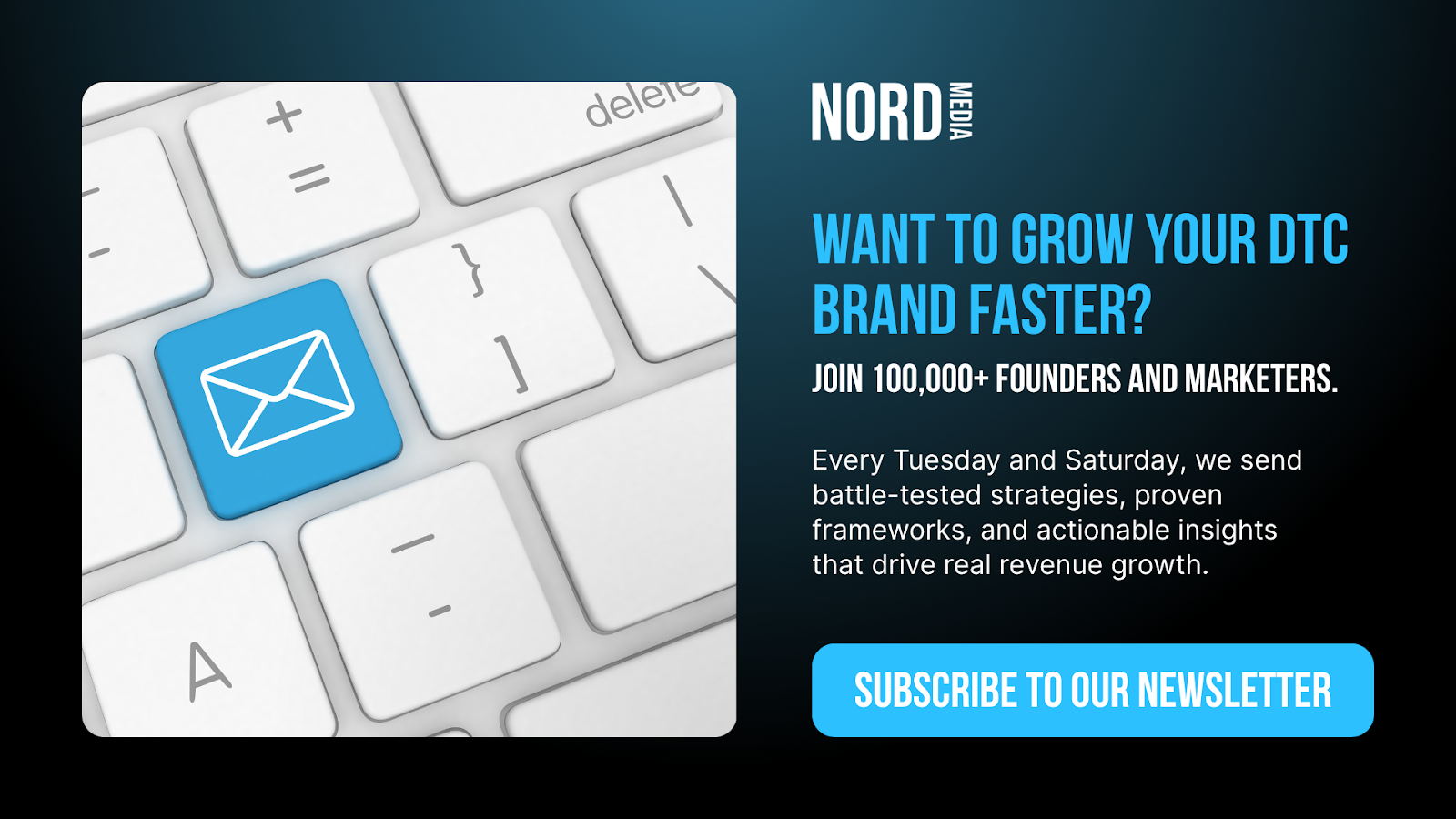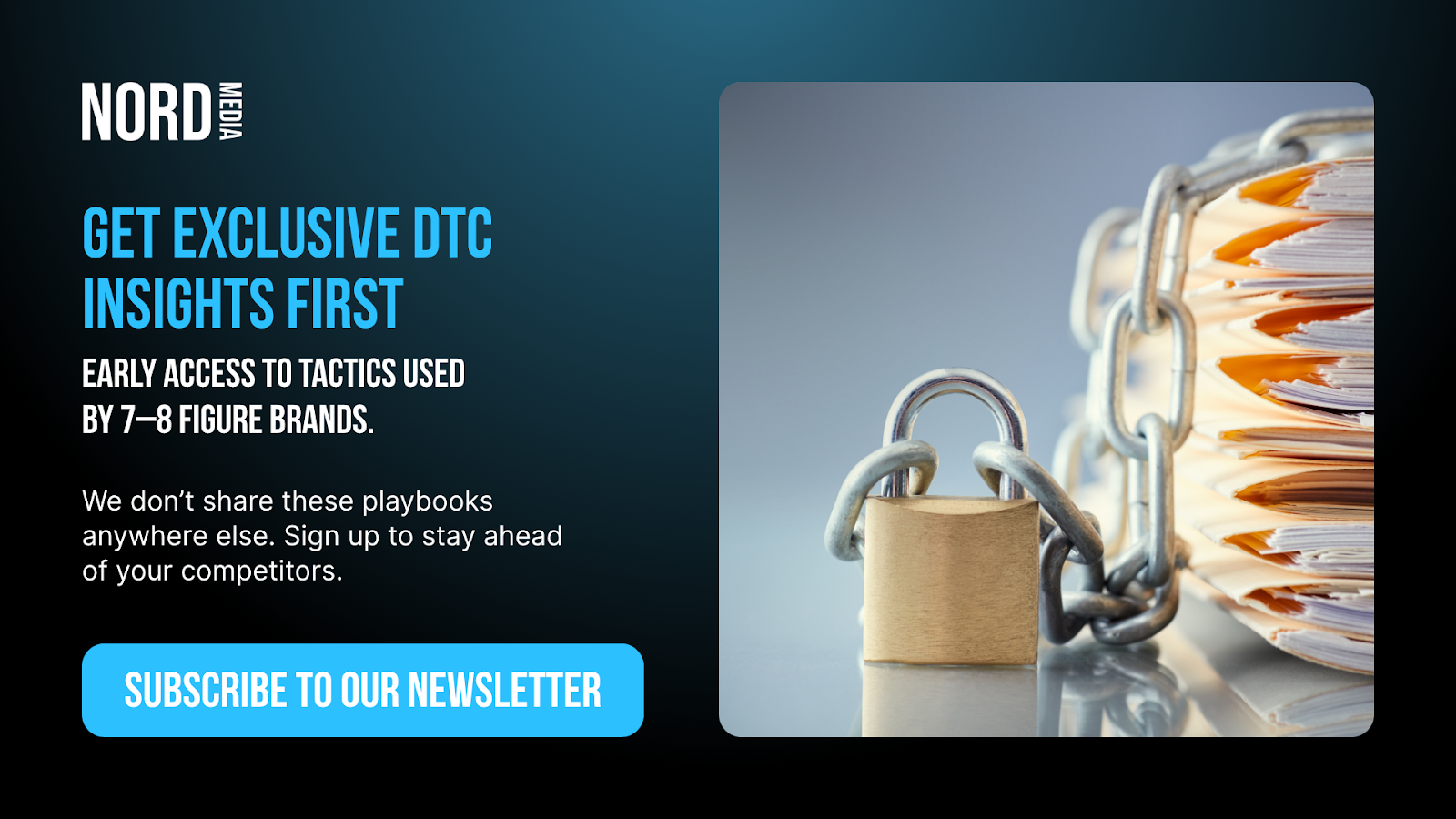Key Takeaways:
- ROI > ROAS: Don’t just track immediate returns; evaluate lifetime value, payback period, and sustainable profit when measuring Google Ads success.
- Target Quality Over Volume: The most profitable accounts focus on acquiring high-intent, repeat customers rather than chasing low-cost clicks.
- Optimize The Full Funnel: Strong creative, refined targeting, optimized landing pages, and holistic attribution are essential to scaling Google Ads profitably.
For eCommerce brands, the real question isn’t just where to advertise, it’s whether ad spend is driving bottom-line impact. You’ve likely asked: are Google Ads worth it? With acquisition costs rising and competition fierce, every dollar must deliver sustainable growth, not just traffic spikes.
At Nord Media, we’ve managed over $200M in ad spend across DTC startups and global brands, and we’ve seen how properly engineered Google Ads fuel steady revenue, loyal customers, and compounding profit. Too often, though, brands chase short-term ROAS instead of true ROI.
This article breaks down what eCommerce brands must know about Google Ads ROI, focusing on the data, strategy, and creative that make it a profitable, scalable growth channel.
Defining Success: What Does A Good ROI On Google Ads Look Like?
Understanding the return on investment (ROI) for Google Ads is essential, especially in today’s ever-evolving eCommerce landscape. Here’s how smart eCommerce operators evaluate success:
Beyond ROAS: Measuring True Growth
Too often, success is narrowly defined by return on ad spend (ROAS). While a healthy ROAS (e.g., 3:1 or higher) is essential, brands that only focus here risk missing the bigger picture. Sustainable ROI means measuring lift in gross profit, improvements in customer acquisition cost (CAC), and recurring lifetime value (LTV), not just the immediate revenue. The most successful companies analyze downstream metrics and prioritize efficiency throughout the funnel.
Customer Quality vs. Click Volume
Not all clicks, leads, or even first-time purchases are created equal. Winning accounts don’t just look for low-cost conversions; they zero in on customer cohorts that return repeatedly and evangelize the brand. Use Google Ads to filter for high-intent buyers and analyze post-click behavior: Do new customers return, increase average order value, or buy again within the first 90 days? A good ROI is built on quality acquisition, not just quantity.
Efficiency At Scale: Sustainable Margins
As media spend increases, margin erosion is a real threat. A true assessment of Google Ads ROI factors in rising costs per click as competition intensifies. Brands with a “good” ROI have workflows in place to reinvest profit into creative testing, bid strategies, and segment-specific messaging, so that CAC stays in line even as total investment grows.
From Attribution To Action: The Role Of Reliable Data
Clean data fuels confident decisions. Attribution needs to be clear and granular; the best operators pay attention to both direct and assisted conversions. This multi-touch approach reveals which campaigns truly drive incremental growth, helping brands avoid the trap of over-investment in vanity metrics.

How Google Ads Works for eCommerce: The Searcher's Journey
Effective Google Ads campaigns do more than just surface your product; they insert your brand into the customer’s discovery process at crucial decision points. Understanding this journey is essential for eCommerce brands and forms the backbone of any strong ecommerce growth strategy.
Awareness: The Initial Touchpoint
Every journey starts with a problem or desire. A potential customer heads to Google, searching for an answer or a product. At this stage, well-targeted search ads put your offerings on their radar, even before brand preferences form. This is where keyword intent and ad relevance set the stage for everything that follows.
Consideration: The Information Gathering Phase
Now, research intensifies. Shoppers compare prices, read reviews, seek out alternatives, and evaluate options. Google Shopping and remarketing ads keep your products top-of-mind, following users as they dive deeper. Strategic ad creative and smart bidding mean your visibility doesn’t just continue, it strengthens, nudging prospects towards your storefront over competitors.
Decision: The Moment Of Conversion
Conversion isn’t luck, it’s engineered. At this stage, the searcher, already familiar with your offer, searches with greater intent, using transactional keywords like “buy,” “best price,” or product-specific queries. Highly optimized paid search and dynamic remarketing ads capitalize on this high purchase intent, sealing the deal when it matters most.
Post-Purchase: Retention And Advocacy
The journey doesn’t end at checkout. Through smart remarketing, Google Ads can re-engage customers with tailored offers, cross-sells, and loyalty campaigns, turning first-time buyers into repeat customers and brand advocates. The result is growth that compounds, not just spikes.
Beyond The Click: Measuring True ROI For Your eCommerce Store
Data-driven growth begins with clarity on what is paid media and how its outcomes should be measured. The real value lives beyond your dashboard's click-through rates and surface-level ROAS. Sustainable profitability requires a framework for measuring true returns, the kind of impact your CFO cares about, not just your media buyer.
The Pitfalls Of Focusing On ROAS Alone
It's tempting to zero in on return on ad spend as your north star, but ROAS often masks the bigger financial picture. A high ROAS doesn't mean it's supporting your margin targets, compounding revenue, or acquiring customers who return again and again. For eCommerce brands especially, it's crucial to drill down into post-click performance, lifetime value, and contribution margin.
The Metrics That Actually Matter
Start by expanding your KPI set. Look at:
- Customer Acquisition Cost (CAC): How much are you paying, all-in, for each new customer, not just each conversion?
- Customer Lifetime Value (LTV): Are your ad-driven customers worth more over time, or are they one-and-done deal shoppers?
- Blended Revenue Impact: Measure how your paid traffic influences total revenue, including organic and direct, since effective ads often strengthen other channels.
- Payback Period: How quickly do you recoup your ad investment through profit, not just topline sales?
Attribution: Getting Closer To The Truth
With privacy changes and channel fragmentation, single-touch attribution will mislead you. Multi-touch or data-driven attribution, married with backend analytics, allows you to see who clicked and who actually purchased, returned, and became a profitable long-term customer.
Operational Efficiency And Scale
True ROI leaves no room for wasted spend. Periodically audit your funnel for leakages post-click. Optimize not just ads, but landing pages, upsells, and retargeting flows. A disciplined approach to testing and refinement amplifies profitable growth instead of fueling a race to the bottom.

Factors That Impact Your Google Ads ROI (And How To Control Them)
Profitability from Google Ads doesn’t happen by accident. It results from careful paid media management and understanding the variables that drive returns. Here’s what really moves the needle:
Targeting Precision: Are You Reaching Your Ideal Customers?
The accuracy of your audience targeting determines how much budget is wasted (or maximized). Misaligned targeting means paying for clicks from users who’ll never convert. Tight targeting, leveraging demographic, geographic, and intent-based factors, sharply increases the odds that every impression or click is an opportunity, not just an expense.
Control It:
- Rigorously test ad groups and keywords
- Use negative keywords to eliminate waste
- Refine audiences with first-party data.
Creative Relevance: Does Your Messaging Resonate?
Creative that speaks directly to the buyer’s needs, pain points, and desires significantly increases click-through rates and conversion rates. Bland or generic ads get scrolled past, especially in competitive markets.
Control It:
- Refresh copy and visuals regularly
- Mirror search intent in ad headlines and descriptions
- Use dynamic creative to personalize messaging.
Landing Page Experience: Can You Convert Clicks Into Customers?
Even the highest-intent traffic won’t convert if the landing page is slow, confusing, or off-message. Friction at this stage tanks ROI, while streamlined, persuasive landing pages lift performance.
Control It:
- Test page speed and mobile optimization
- Align landing page content with ad messaging
- Use clear calls-to-action and trust signals.
Budget Allocation: Are You Spending Smarter, Not Just More?
ROI isn’t just about how much you spend, but where you spend it. Allocating budget across the right campaigns, keywords, and audiences ensures every dollar has a purpose and can be traced to results.
Control It:
- Set up granular tracking for each campaign
- Shift spend toward top-performing assets
- Regularly audit and pause underperforming elements.
Full-Funnel Measurement: Are You Seeing The Real Picture?
Looking only at surface metrics, like clicks or raw ROAS, can mask gaps in efficiency or missed opportunities. Holistic measurement, factoring in lifetime value, incremental revenue, and assisted conversions, gives a truer picture of your real return.
Control It:
- Implement first-party tracking and conversion APIs
- Attribute results across the full customer journey
- Analyze lifetime value, not just single-touch conversion rates
Google Shopping vs. Search: Which Ad Type Is Best For Your ROI?
Both have unique strengths, but how do you know which fits your ecommerce growth strategy better? Let’s break down the differences and impacts on your bottom line. For many marketers, the debate comes down to understanding google ads vs facebook ads and where each channel fits into the funnel.
Shopping Ads: Visual Impact And Purchase Intent
Google Shopping ads showcase your products directly in the search results with images, pricing, and brand information. This visual format is designed for users who are already in buying mode. They’re highly effective at capturing demand for specific products, often resulting in higher conversion rates at favorable cost-per-acquisition levels.
Key benefits include:
- High Purchase Intent: Buyers clicking Shopping ads are typically closer to conversion, as they see exactly what’s being offered before clicking.
- Rich Product Information: Product imagery and pricing upfront can qualify leads, reducing wasted clicks.
- Enhanced Brand Visibility: Shopping campaigns display multiple products, increasing the chance to dominate more SERP real estate.
However, Shopping campaigns demand a robust product feed and impeccable inventory management. Success hinges on the depth and accuracy of your product data.
Search Ads: Flexibility And Funnel Coverage
Search campaigns are keyword-driven and text-based, granting more control over messaging and targeting. They’re perfect for capturing broader intent, such as “best running shoes for flat feet”, searches that indicate research phase or brand consideration rather than just ready-to-buy clicks.
Advantages include:
- Full-Funnel Reach: Search ads allow you to target buyers at every stage, from discovery through consideration to conversion.
- Highly Customizable: Copy, extensions, and landing pages can be tailored to different audience segments and search intent.
- Brand Lift: Text ads support messaging around promotions, value props, and unique differentiators beyond just product specs.
Search campaigns are often vital for competitive brand defense, ensuring your business remains visible when shoppers are comparing alternatives.
Choosing The Right Mix: What Actually Drives ROI?
The strongest Google Ads strategies for eCommerce rarely depend on a single format. Instead, ROI is maximized by mapping specific ad types to buyer journey stages, optimizing spend allocation, and adapting creative and offer strategies to match audience intent. Remember this framework as you explore measuring success, because actual value isn’t just about today’s clicks, but tomorrow’s customers and compounding revenue.
Measuring Long-Term Impact: Looking Beyond Immediate Metrics
Too many eCommerce brands get stuck evaluating Google Ads on surface-level KPIs like CTR or short-term ROAS. While these numbers provide quick feedback, they rarely tell the full profitability story. Google Ads' real value lies in its ability to compound over time by building customer relationships, improving brand recall, and feeding retargeting and lifetime value (LTV) strategies.
Metrics such as MER (marketing efficiency ratio), payback windows, repeat purchase rate, and customer lifetime value provide a clearer view of long-term ROI. A campaign that looks expensive up front can deliver the highest returns once customer retention and upsells are factored in.
By shifting focus from short-term wins to long-term impact, brands unlock Google Ads' true potential as a sustainable growth channel.

Final Thoughts
Google Ads can be an eCommerce brand's most profitable growth channel, but only when ROI is measured beyond surface-level metrics like clicks and short-term ROAS. Partnering with an experienced google ads agency ensures your strategy isn’t just about traffic, but long-term profitability, customer lifetime value, and full-funnel efficiency. With the right mix of targeting, creative, data-driven attribution, and ongoing optimization, Google Ads becomes a sustainable revenue and brand loyalty engine.
Read also:
- The Ultimate Ecommerce Growth Strategy: How To Scale Profitably In 2025
- Facebook Ads Vs Google Ads: Performance Benchmarks For Ecommerce Marketers
- What Is Paid Media And Why It’s Essential For Scaling Your Online Store
Frequently Asked Questions About The ROI Of Google Ads: What eCommerce Brands Need To Know
How do you find ROI in Google Ads?
To calculate ROI in Google Ads, subtract the total ad spend from the revenue generated by those ads, then divide that number by the ad spend: ROI = (Revenue – Ad Spend) / Ad Spend. A positive ROI means your campaigns are generating profitable returns.
Is Google Ads good for ecommerce?
Yes. Google Ads offers high-intent targeting, measurable results, and scalable campaigns, making it one of the most effective channels for eCommerce brands wanting to drive sales and acquire new customers quickly.
What is the 20 rule for Ads?
The “20 rule” usually refers to ensuring that ad headlines or visuals don’t exceed 20% of text, optimizing readability and engagement. Though platforms like Facebook have phased out strict enforcement, it’s still a smart best practice for clarity.
What is the 7 times 7 rule in marketing?
The “7 times 7” rule suggests that a prospect needs to see your message at least seven times to remember and act on it. It underscores the importance of consistent, repeated exposure across multiple touchpoints.
What is the 70 20 10 rule in marketing?
This rule states that 70% of your content should focus on what works and directly supports your core business, 20% should be innovative or slightly riskier, and 10% should be high-risk, experimental ideas. This mix keeps your marketing both stable and forward-thinking.
What is the 40-40-20 rule in marketing?
This classic formula breaks down marketing success as 40% audience targeting, 40% offer or message, and 20% creative execution/design. It highlights the importance of knowing your audience and crafting compelling offers over simply making flashy ads.












